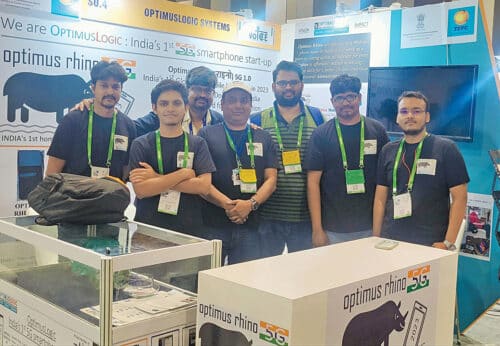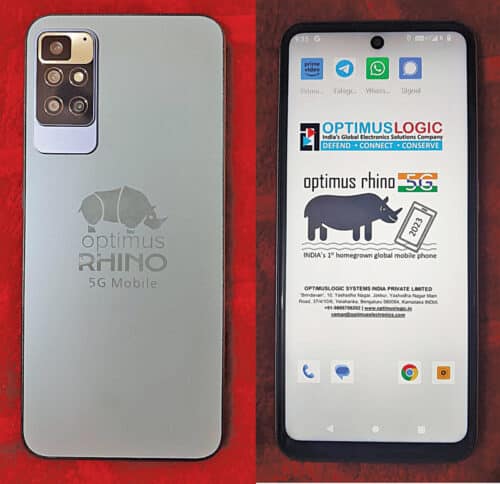Defence startup OptimusLogic Systems, based in Bengaluru, is making waves across all bands of the 5G spectrum with their indigenously designed 5G mobile phone
Throngs of people and the telecom behemoths bore witness on October 1, 2022, as India was ushered into a new era of technological advancements with the inauguration of the 5G band, at the 6th Edition of India Mobile Congress 2022, at Pragati Maidan, New Delhi. On this momentous occasion, a small but enterprising group of individuals unveiled India’s first indigenously manufactured 5G smartphone—Optimus Rhino 5G.

Founded in 2013 by Chandra Kumar Chettiar as a startup that built devices and subsystems for defence PSUs such as BEL and DRDO, OptimusLogic Systems Pvt Ltd began their journey with an initial investment of ₹20 million. As a Digital Communication Innovation Square (DCIS) scheme grantee, and with the support of the Department of Telecommunications (DoT), the company has been able to manufacture a 5G smartphone that can support all the 5G bands in a very small form factor.
The phone is currently available in three different models—Optimus Rhino 5G 1, Optimus Rhino 5G 2, and Optimus Rhino 5G 4 (rugged MIL-810G/IP68).
Out of the total smartphone base of about 600 million in India, only 50-60 million handsets are estimated to be 5G smartphones, even as the first 5G smartphone was unveiled in 2020. The Optimus Rhino 5G is an indigenous product of the Voice of Indian Communication Technology Enterprises (VoICE) consortium, which asked multiple technology and R&D players to set up a 5G based mobile communication network in the 82km Palwal-Mathura sector of the Indian Railways on 700MHz band.
“Most of the phones manufactured by a consumer brand support the N78 (3500MHz) frequency band. If you take multiple use cases for the army and the railways, they have been allotted the 5MHz spectrum in the 700MHz band, because the lower the frequency, the higher the range. Optimus Rhino 5G supports all these bands and global network bands of major countries,” explains Chettiar.
The Optimus Rhino 5G 1 comes with a large storage capacity of 8GB RAM, 128GB flash drive, and a quad camera setup at a modest price of `20,000. Consumers also have the option of getting a discount of ₹2,000 if they choose to assemble the phone on their own and order the assembly kit.
It has an octa-core MediaTek Dimensity 900 processor and an ARM Mali-G68 graphics processing unit. It supports 17 5G bands starting from B1 to N78. The phone can connect with a 5G network anywhere across the globe in standalone (SA) and non-standalone (NSA) modes.
With a 17cm (6.7-inch) in-cell display and an FHD+ resolution (1080×2460 pixels), the phone supports 120Hz refresh rate for smoother animations and scrolling experience. The Android 12 mobile phone runs on a 5000mAh lithium-polymer battery with a standby time of 200 hours. It comes with a built-in NFC; the later models will use the Indian Regional Navigation Satellite System (IRNSS) navigation system NavIC.
The designing of the phone began in 2020 when the world was grappling with Covid. Due to their association with the defence sector, the company worked throughout the pandemic, with salary cuts to generate funds for designing and developing the phone.

Chettiar and his team are currently readying themselves to market the product and showcase it in various exhibitions. “We are already running a test run across the government departments, where about 10,000 phones will be tested for working in India. Once we cross that we shall be ready for mass production,” says Chettiar.
While the PCB was designed in-house, the outsourced components were assembled in their office. The team intends to target the consumer market and defence PSUs in the initial marketing stage. It is currently in talks with VVDN Technologies for a commercial manufacturing facility for the phone. The company plans to subsequently white-label the PCB design for different platforms and sell it to other companies.
The team outlined the company’s vision with the prospect of approaching venture capitalists to set up their manufacturing unit. “Our vision is to be a global original design manufacturer (ODM) and design devices for the world. As our clientele increases, we will aim to set up a general-purpose manufacturing unit, which will not be targeted specifically to a particular device but support any embedded system design,” the team told EFY.





